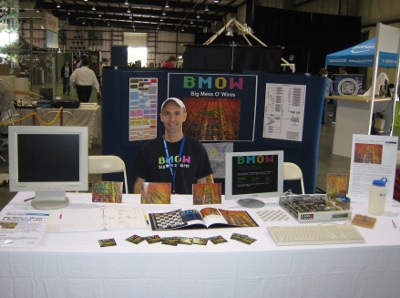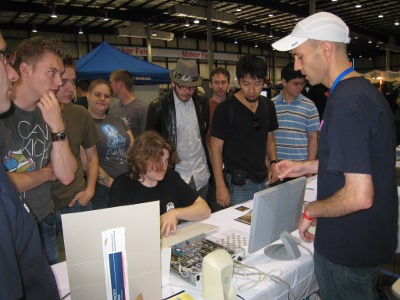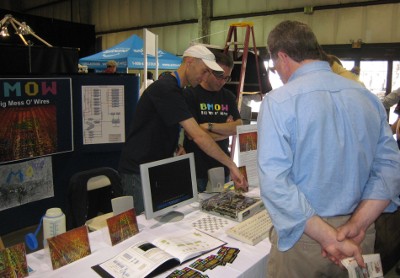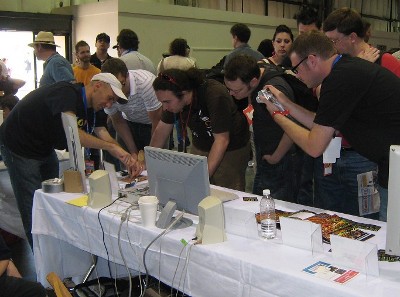Archive for the 'BMOW 1' Category
The Vintage Computer Festival is Almost Here!
Vintage Computer Festival West XI is happening next weekend, August 6-7 at the Computer History Museum in Mountain View, California. I’m belatedly dusting off the hardware for my exhibit and preparing the demos and signage. Anybody have a trade show style backdrop they’d like to lend me? 🙂
I’ll be exhibiting three of my hand-made computer creations, each of which has gone through some modifications for the show:


BMOW 1 – My original custom-made CPU and computer that kicked off this blog and my journey into hobby electronics. BMOW 1 is an 8-bit CPU, implemented with 7400-series TTL discrete logic and a few PALs. Built around this is peripheral hardware for I/O, sound, and video. The end result is a custom creation that’s vaguely similar to an Apple II in its performance and capabilities. And it’s all hand wire-wrapped, with thousands of individual wires.
New for VCF West, I’ve cut a porthole in the bottom of the case and added interior case lighting, to showcase the glorious mess of wires inside. I was nervous I’d break something while removing and replacing all the parts in the case, but BMOW survived and is still running strong.
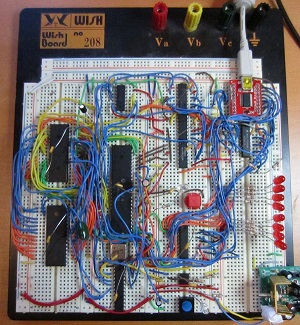
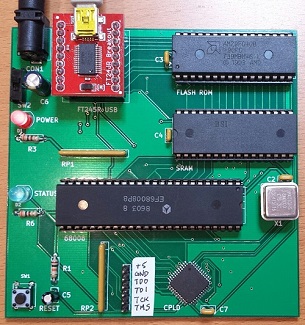
68 Katy – A 68000-powered single-board Linux system that began life as “Linux on a breadboard”. It’s a super-minimal Linux system containing only a 68K family CPU, 512K ROM, and 512K RAM. I began with a 16 year old Linux distro and hacked it to support this hardware and its tiny memory size. The original version was literally built on a breadboard, though the current version is now a PCB with a serial port for I/O.
During testing for the VCF show, I found that 68 Katy was no longer running reliably. I’d previously overclocked the 8 MHz-rated 68008 CPU to 12 MHz. Restoring an 8 MHz oscillator seemed to fix the problems – for now.
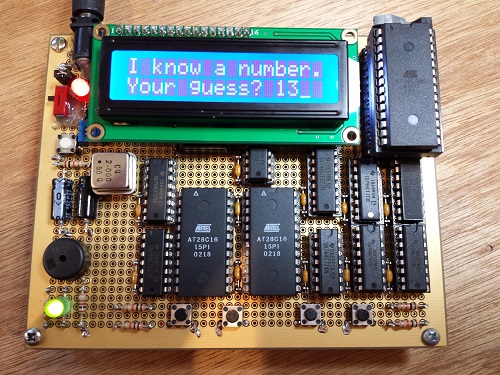
Nibbler – Another custom-made CPU and computer with a 4-bit (nibble) architecture. Designed to be simple to build and easy to understand, Nibbler’s CPU core consists of just 13 discrete 7400-series logic chips – individual counters, registers, buffers, and gates. To complete the machine, it adds a few ROMs and an SRAM, as well as pushbuttons, an audio speaker, and a text display. With a 4-bit CPU and 4K of memory you might think Nibbler couldn’t do anything much more interesting than blink an LED, but it boasts some nice games and demos. Like BMOW 1, it’s all hand wire-wrapped.
Nibbler will see a significant change for the VCF show, time permitting. The original design uses a 4K ROM for storing the program – when you want to run a different program, you need to replace the ROM. I plan to substitute a 16K ROM with a DIP switch to control the highest two address lines, so I can select between four different stored programs without resorting to ROM swapping.
Antique and Custom Computers Galore
Beyond the BMOW stuff, the other exhibits planned for VCF West XI look great! They include Eric Schlaepfer’s MonSter 6502, Bill Buzbee’s Magic-1, vintage DEC and Data General systems, IBM mainframes, Amigas, TRS-80s, S-100 hardware, and much more. Check out the full list here.
The show hours are 9:30-6:00 on Saturday the 6th and 9:00-5:30 on Sunday the 7th. Do you plan to attend? Leave a comment below, and I’ll keep an eye out for you!
Read 1 comment and join the conversationSee BMOW at VCF West, August 6-7
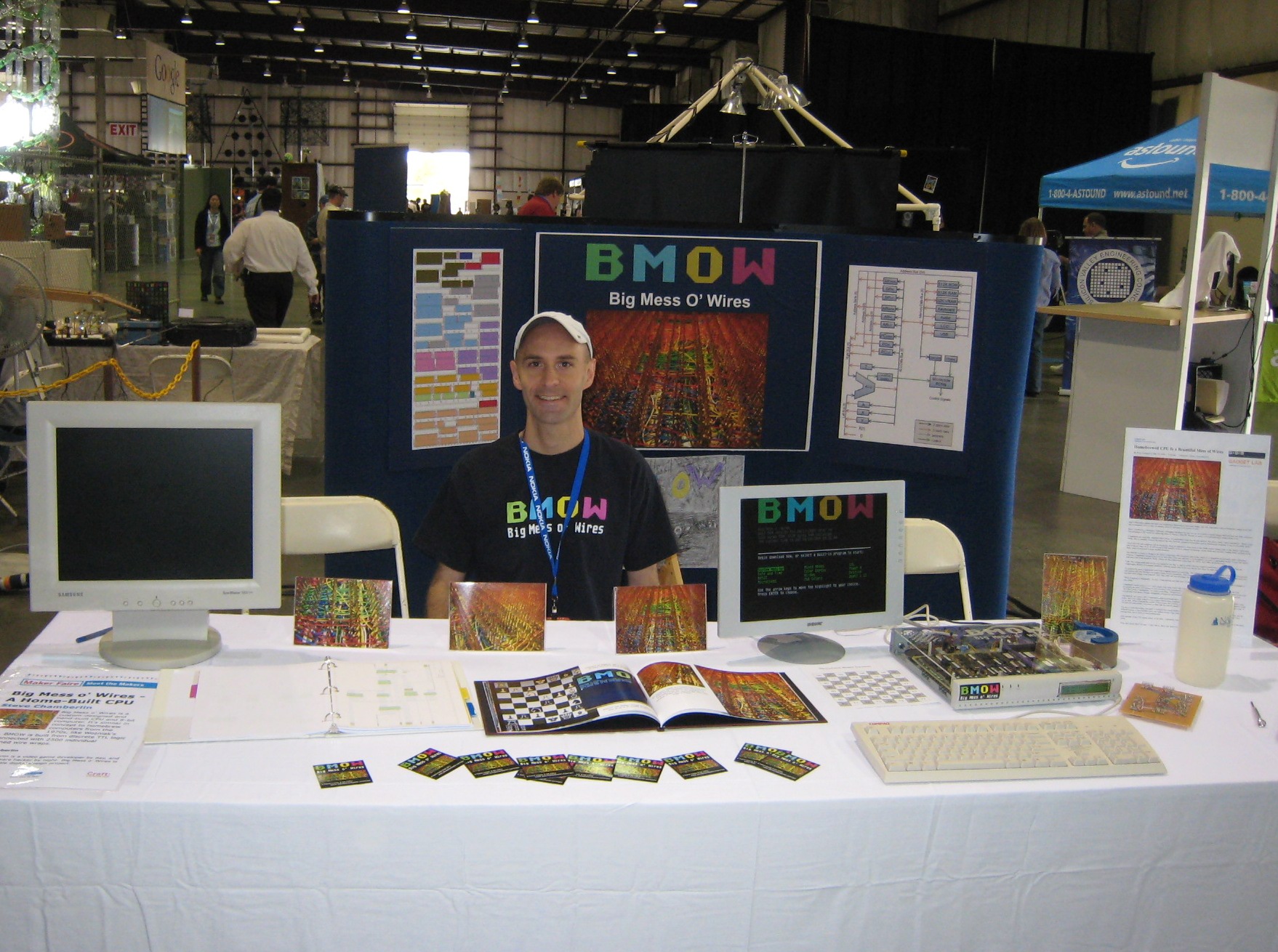
After 7 years of sitting quietly in storage, my BMOW 1 hand-made computer is ready for a new public appearance! I’ll be exhibiting at the Vintage Computer Festival, August 6-7 in Mountain View, California. Along with BMOW 1, I’ll also be demonstrating Nibbler, 68 Katy, and some other home-made CPU madness. Come join the fun!
If you don’t remember BMOW 1, it was my first adventure into homebrew digital electronics, and it gave birth to this blog. The machine itself is a custom-designed 8-bit CPU, implemented with 7400-series TTL logic and a few PALs. Built around this is peripheral hardware for I/O, sound, and video. The end result is a custom creation that’s vaguely similar to an Apple II in its performance and capabilities.
Remember these photos from 2009? BMOW 1 was built on a large wire wrap board, with about 2500 individual hand-placed wraps connecting all the components. I had a giant spreadsheet to keep track of it all. It took over a year. I think I was insane. There’s no way I’d do that again now. 🙂

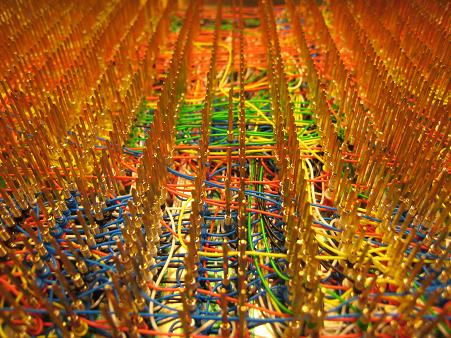

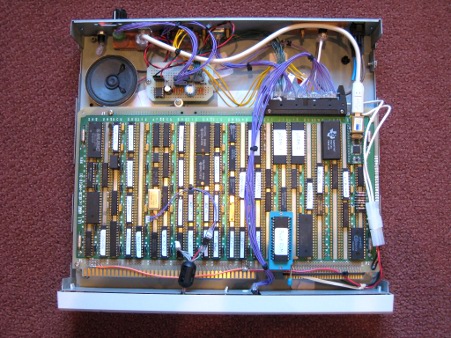
In preparation for VCF, I dug BMOW 1 out of storage. It still works! That’s a good thing, because I’ve forgotten most of its details and it’s unlikely I’d be able to repair it now. The Maker Faire 2009 demo was still loaded in ROM, so I spent a little while playing through the demos and listening to some rocking chip tunes. You know what? That thing is pretty fun.
I had a “doh!” moment in connection with the VCF exhibit. After Maker Faire 2009, I saved all the printed materials, posters, schematics, code listings, photos, stickers, and other materials you can see in the booth photo above… until last weekend when I threw them all in the trash. Then just days later, I was invited to exhibit at VCF.
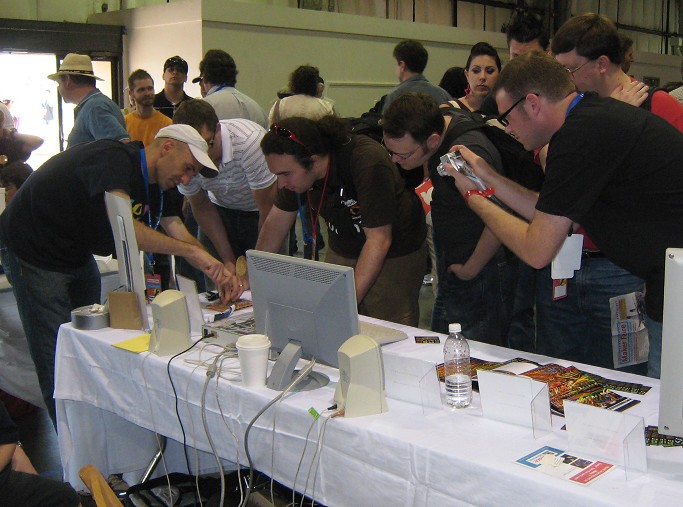
There’s one important mod I need to make before August 6. At Maker Faire there must have been a thousand people who came to see the “big mess of wires”, and went away disappointed when they learned that the wires were hidden out of sight in the final BMOW 1 case. The case has a transparent top to showcase all the chips, but the wire wrap is on the bottom side of the board and is rendered invisible. That’s a shame.
For VCF I’d like to make both sides of the board visible. That means standing the case vertically, and cutting a window into the bottom of the case, both of which worry me. A vertically-mounted case creates a risk it can tip over and get damaged, so it will need some very sturdy feet or anchoring system. And cutting a window in the big steel bottom plate… I stink at anything related to metal working. For the original case design, I cut some much smaller openings in the case with a Dremel tool, and it was incredibly slow. I also destroyed the Dremel in the process.
Read 1 comment and join the conversationGoodbye BMOW, and a Contest
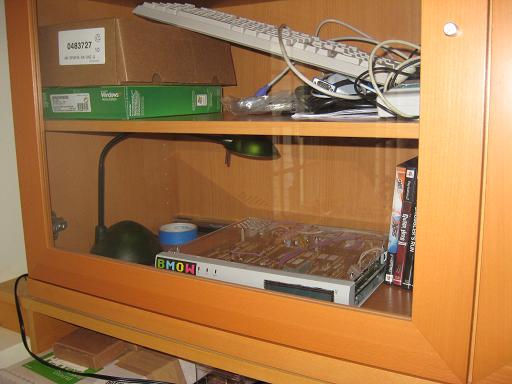 It’s a bittersweet day today. After 18 months of development, occupying the top of my desk and the majority of my spare time, BMOW 1 has been officially retired to the closet. I packed up the case, packed up the power supply, keyboard, cables, EPROM programmer, and everything else. At least it had a good send-off party at the Maker Faire. Now I can actually see the surface of my desk for the first time since 2007, and I’m ready to turn my full attention to my next project.
It’s a bittersweet day today. After 18 months of development, occupying the top of my desk and the majority of my spare time, BMOW 1 has been officially retired to the closet. I packed up the case, packed up the power supply, keyboard, cables, EPROM programmer, and everything else. At least it had a good send-off party at the Maker Faire. Now I can actually see the surface of my desk for the first time since 2007, and I’m ready to turn my full attention to my next project.
To mark the occasion, I’m running a small contest, with ten fabulous BMOW stickers as the prize. If you’ve followed my progress for a while, then you know that the “C” key doesn’t work in BMOW BASIC, due to a bug related to control-C handling that I never bothered to fix. The contest is simple: write a BMOW BASIC program that prints the letter C to the screen, without typing “C” as part of the program. This isn’t as easy as it might seem, since many of the relevant BASIC keywords also have the letter C in their name.The first person to reply with a working solution, as judged by me, will receive the stickers by mail, and the honorary title of “BMOW Guru”. It’s not quite like being knighted, but it’s close.
Some hints:
- BMOW BASIC is a straight port of Microsoft BASIC, but does not include any machine specific commands for file I/O, graphics, etc. Do a Google search to learn more about MS BASIC keywords.
- The video memory is not mapped anywhere into the BASIC address space, so you can’t just POKE a byte into screen memory.
- Try this Javascript Applesoft BASIC interpreter, which is also a Microsoft BASIC variant. But remember, BMOW BASIC isn’t 100% identical to Applesoft. Try the BMOW simulator on the Downloads page if you’re unsure.
Aftermath
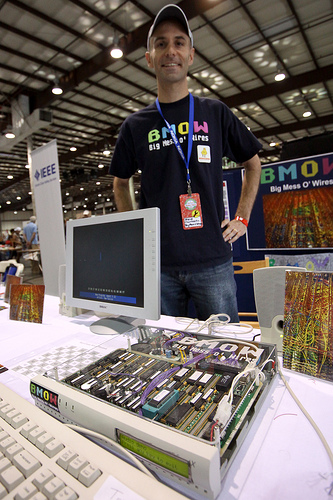 Photo by Joe Pankow Oh ye gods! Crazy, nutty, insane. The past few days have been among the strangest of my life. I think I’ve had my 15 minutes of fame and then some. First there was the article about BMOW 1 on Wired.com, then the story got picked up by CNet, Digg, Slashdot, Engadget, Gizmodo, Reddit, and many others, all over the web. My inbox overflowed with people asking about the project. Then came the Maker Faire, where a few thousand people came through the BMOW booth over a two-day period. People were amazingly enthusiastic, and quite a few people told me they came to the Maker Faire specifically to see BMOW! In the Wired article about “What to do at the Maker Faire“, BMOW was even the featured attraction for the entire event. In the end, it won an editor’s choice award for the show, and I talked myself hoarse.
Photo by Joe Pankow Oh ye gods! Crazy, nutty, insane. The past few days have been among the strangest of my life. I think I’ve had my 15 minutes of fame and then some. First there was the article about BMOW 1 on Wired.com, then the story got picked up by CNet, Digg, Slashdot, Engadget, Gizmodo, Reddit, and many others, all over the web. My inbox overflowed with people asking about the project. Then came the Maker Faire, where a few thousand people came through the BMOW booth over a two-day period. People were amazingly enthusiastic, and quite a few people told me they came to the Maker Faire specifically to see BMOW! In the Wired article about “What to do at the Maker Faire“, BMOW was even the featured attraction for the entire event. In the end, it won an editor’s choice award for the show, and I talked myself hoarse.
While I appreciate all the attention this project has suddenly received, I have to admit I feel like a fraud. For one thing, Bill Buzbee’s fabulous Magic-1 homebrew computer was also at the Maker Faire, and it’s twice as cool as BMOW, but didn’t get nearly the press coverage. I also think that most of the people talking about BMOW thought it was something it’s not. A lot of people seemed to have the idea that I’d built a CPU entirely out of wires, as if wires themselves could perform computations. Or they thought I’d built some kind of giant machine the size of a refrigerator. When they saw a rather ordinary-looking 12 x 8 inch board at the show, they looked disappointed. Many people also seemed to have the idea that I’d built a CPU out of thousands of individual transistors. Nope. BMOW is made from sixty-five chips including 7400-series parts, 22v10 PALs, ROMs, SRAM, a video DAC, and an AY audio chip.
It was an incredible time at the Maker Faire. Setup began on Friday, so I was able to get in before the show opened to the public, and chat with some of the other Makers before the crowds arrived. The show is sprawling, massive: two giant expo halls, plus all the grounds between and around them, and half of an enormous parking lot. It was really too much to experience in a single day.
One downside of being a Maker presenting BMOW is that I didn’t get much chance to visit the other exhibits. Fortunately, I did have a chance to talk with a few amazingly brilliant people. I spoke to Jeri Ellsworth, creator of the C-One reconfigurable retro-computer (who was demoing DIY transistors), Limor “Lady Ada” Fried, inventor of all manner of Arduino and other electronic projects, and evilmadscientist.com’s Windell Oskay, who was demonstrating the Candy Fab 6000 sugar-based 3D printer. There were also many other amazing and creative people I spoke to, not all of whose names I caught, but it was great to get wrapped up in an aura of geeky achievements with them all.
Thanks to everyone who came by the BMOW booth at the Faire, and to my friends Kevin and Eric for helping out as BMOW crew members for the weekend. The booth was packed almost non-stop from open to close, both days. If I’d had the foresight to make extras, I could have sold a ton of books and T-shirts, and lots of people asked about them. Some people even asked about buying kits. I can only assume they had a spare year with no particular plans, and were looking to fill it. A few people came by the booth and gave me free stuff! A guy from Parallax gave me a Propeller development board. I’ll definitely have to play around with that.
A few questions about BMOW came up again and again:
- “What’s the operating system?” When I answered “there isn’t one”, this seemed to blow people’s minds. How could you have a computer without an OS? For BMOW the hardware is so simple, the programs themselves essentially *are* the OS.
- “What compiler did you use to write programs?” Some people seemed genuinely astounded that it’s possible for a human to write programs in assembly language. Whether they’re too young to remember when that was the norm, or have just spent too much time coding in Python or something, I don’t know. Yes, it’s all BMOW assembly language, which is mostly identical to 6502 assembly. I tinkered with retargeting a C compiler for BMOW, but never went very far with it.
- “Where are the wires?” Ah yeah. I supposed it’s false advertising to have a project called “Big Mess o’ Wires”, and not have a giant hairball of wiring hanging out somewhere. There wires are all hidden on the underside of the system board. Sorry.
In the end, BMOW won a Maker Faire Editor’s Choice award. In fact, it won one twice. I’m not really sure what happened there, but when the second editor came by with Lady Ada to give me the award, and heard that someone else had already given me one, he seemed pretty ticked. I’m guessing maybe different editors were supposed to give awards in different categories, and two different editors claimed BMOW in their category. Regardless, I’m thrilled and excited to be recognized by Make.
To the guy I talked with who’s got some unused wire-wrap boards, please send me an email, and I promise to give them a good home. To the guy who turned out to live down the street from me in Belmont, email me, and maybe we can hook-up for some neighborhood nerd projects. For anyone else who emailed me already, if I didn’t reply, try me again.
Last but not least, I’m taking orders for SWAG. If you’d like a few BMOW stickers, send me a SASE or $0.50 by PayPal, and I’ll get you some. I’ll also be placing another order for BMOW T-shirts in a week, on June 7. If you’re in the USA, send me $28 by PayPal before the 7th, along with your shirt size, and you’ll get a shirt in a couple of weeks. If you’re outside the USA, email me to ask about shipping costs. Sorry, but 5-color silkscreened T-shirts for small run orders aren’t cheap. I’m not making any profit off these.
Whew! It’s been an amazing couple of days, but I’ve had enough. Time to go crack open a beer.
Meeting Bill Buzbee, creator of the Magic-1:

A day at the Maker Faire:
Read 10 comments and join the conversationBMOW Project Summary
Crazy day today! Maker Faire setup begins tomorrow, and BMOW is featured on wired.com, and is the #1 Top in All Topics story on Digg! Oh man, this poor server is getting hammered.
Many people have asked for high-res photos. See this entry from February, and click any of the thumbnails to get the high-res versions of wire-wrapping craziness.
For people interested in viewing or buying the “Making of BMOW” photo book, you can order it from Shutterfly here.
Here’s a summary of the project, for everyone following the link from the article.
Big Mess o’ Wires 1 is an original CPU design. It does not use any commercial CPU, but instead has a custom CPU constructed from dozens of simple logic chips. Around this foundation is built a full computer with support for a keyboard, sound, video, and external peripherals.
My original goals were:
- Build the CPU from scratch, primarily using basic 7400-series logic. No 6502, Z-80, etc.
- Keep the hardware complexity to a minimum. I’m not an electrical engineer.
- Be capable of running “real” programs, not a 4-bit CPU or toy machine.
- Provide a way to interface with a PC.
- Be fast enough to run interesting programs interactively.
Stretch goals:
- Boot into a simple integer BASIC program, capable of interactively editing and running its own programs.
- Support multiple programs executing simultaneously, via a pre-emptive multitasking OS.
- Provide keyboard input, VGA video and sound output.
Initial design began in November 2007 with a high-level sketch of the CPU internal design. A simplified Verilog hardware simulation proved the key design details. Construction began in earnest in February 2008, using a large wire-wrap board to interconnect the 50 or so chips needed. In April, a half-finished BMOW 1 booted up for the first time, computing fibonacci(12) = 144 using a simple ROM-based program. One by one the original system goals and stretch goals were met, including VGA video, three voice audio, BASIC, and a bootloader for communication with an attached PC. BMOW 1 eventually gained the ability to run complex programs written in assembly or compiled from C. The main construction phase ended in February 2009, with the completion of a customized case to house everything. As of March 2009, Big Mess o’ Wires 1 is fully functional, but will probably never be “finished”.
Architecture
BMOW 1 borrows liberally from other homebrew designs, as well as the MAYBE design presented in the book Computation Structures by Stephen Ward and Robert Halstead. Data busses are 8 bits wide, and the address bus is 24 bits. Four 8-bit registers are used for general data, and three 24-bit registers store the program counter, stack pointer, and a scratch/working address pointer. Registers and the arithmetic and logic unit are interconnected by one data bus, while RAM, ROM, and memory-mapped hardware devices use a second data bus. The ALU also has dedicated left and right data input busses.
Machine language instructions are implemented as a series of micro-instructions, stored in three parallel ROMs to create a 24-bit microcode word. One micro-instruction is executed each clock cycle, and the micro-instruction bits are used directly as enable and select inputs to control all the chips in the machine. Up to 16 micro-instructions may be needed to implement a single machine language instruction.

Note: Some additional devices are not shown here, including the VGA display circuitry and real-time clock.
24-bit addresses allow for up to 16MB of memory, but only a little more than 1MB of combined RAM and ROM is installed. The most-significant byte of the address is called the bank byte, and is normally invisible to programs. The standard instruction set presents a 16-bit interface to programs, with most instructions implicitly referencing the current bank. Cross-bank references are possible, but awkward (think x86 segment registers).
A 512K ROM contains a bootloader/menu program. A USB-to-TTL interface based on an FTDI chip provides an easy way to move data to and from a connected PC. A standard PC keyboard with PS/2 connector is used for keyboard input, and a 24×2 character text LCD serves as a debug output display. Custom video circuitry drives a standard VGA monitor, with a maximum resolution of 512 x 480. A three-voice programmable sound generator provides music and sounds.
BMOW 1 is built on an Augat wire-wrap board pre-populated with thousands of wire-wrap pins. The chips are pushed into the board without soldering, and can be easily removed, similar to a prototyping breadboard. Unlike a breadboard, the pins are individually connected on the underside of the board according to the needs of the circuit design. A wire-wrap tool is used to wrap stripped wire ends tightly around each pin. Wires can be removed fairly easily in case of a mistake. BMOW 1 contains about 2500 such wire wraps.
Specs
- Current clock speed is 2MHz. It could theoretically go to about 3MHz (untested).
- 512 KBytes of RAM, 512 KBytes of ROM.
- Power draw is 10 Watts, 2.0A at 5V.
- VGA video output is 512×480 with two colors, or 128×240 with 256 colors.
- Audio and music is provided by a three-voice programmable sound generator.
- Keyboard input is a standard PC keyboard with PS/2 connector.
- Debug display is a 24×2 character text LCD.
- There are roughly 1250 wires connecting the components, so 2500 individual hand-turned wire wraps.
Please send me your thoughts and questions!

BMOW 1 Photo Gallery









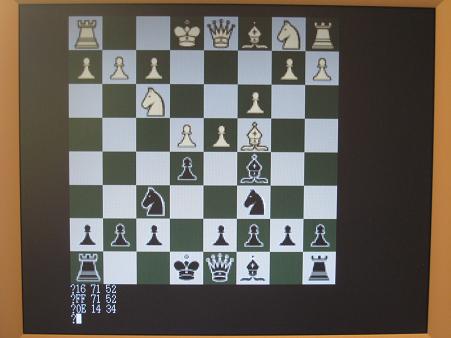
Faire Preparations
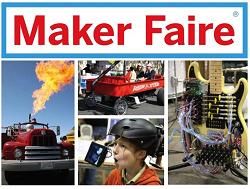 Four more days until the Maker Faire, and preparations have reached a fever pitch. I was interviewed by a Wired reporter on Friday, and a photographer is coming tomorrow to get pictures of me in my “workshop”, which should be good for a laugh. It’s all for an article that will appear on wired.com Wednesday or Thursday.
Four more days until the Maker Faire, and preparations have reached a fever pitch. I was interviewed by a Wired reporter on Friday, and a photographer is coming tomorrow to get pictures of me in my “workshop”, which should be good for a laugh. It’s all for an article that will appear on wired.com Wednesday or Thursday.
Friday is setup day, and I’ve arranged to take the day off from work. It’s not that I really need much setup, but I want to be there while everyone else is setting up, and scope out the exhibits. There are also a couple of Maker-to-Maker events on Friday before the faire opens to the public Saturday morning, including a Maker dinner on Friday night that I’m pretty excited about.
Big Mess o’ Wires will be in the main Expo Hall, booth 296. It’s on the other side of the floor from the Sparkfun booth, in a cluster of about a dozen other small booths. It looks like a pretty good location, near one of the doors so it’ll get some traffic, and not next to the bathroom or behind the stage or someplace similarly odd, so I’m optimistic. I’ve also recruited a couple of friends to be the BMOW crew for the weekend, so there will be someone on hand if I need to leave the booth for a while, or to help handle the teeming crowds that will no doubt be packing the BMOW booth. *cough*
Meanwhile, preparations on the home front are nearly complete. BMOW is fitted with its new transparent laser-etched cover, and tested with its demo attract loop. I’ve got photos, stickers, T-shirts, a “making of” book, and a technical manual with all the schematics and other documentation. I’ve even got a dummy wire-wrap board for people to check out, or try their hand at doing some wraps themselves.
I’ve created a BMOW Powerpoint presentation to answer the questions of “what is this, and why should I care”, which will be looping continuously on another computer in the booth. I welcome feedback on anything that has too much or too little detail, or other general suggestions for improvements.
I hope to meet some of you in person this weekend at the faire!
Edit: The WIRED article about BMOW is up. Thanks Priya!
Be the first to comment!

